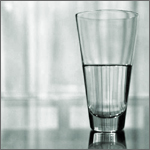
One of the great questions of philosophical platitude of our time deals with the essence of human nature compared to a geometric perplexity or palpability of a cylinder.
“Is the glass half full or is the glass half empty?”
The question itself has been termed a metaphor, or representation of a higher meaning. I have often thought of this question as both a metaphor and a contextual linguistic equation that can be solved absolutely. I have recently decided, the question of whether the glass is half full or half empty is neither, rather a riddle derived from intuitive thinking. Before I state my solution to the riddle, I will state the variety of misconceptions that this question poses.
The most common assumption this metaphor conveys for us is whether a person is optimistic or pessimistic. An optimistic person traditionally views the glass as half full and adversely the pessimist views the glass as half empty. Historically and logically, the optimistic person is let down and the optimistic society is ultimately destroyed because their contentment with life has created insecurities with their relationship with reality. Contrary to this, the pessimistic person is pleasantly surprised and the pessimistic society, like the United States, uses systems to check and balance its leaders to justify its position with reality.
Maybe the glass is the thing we should measure and the liquid inside is the container. Maybe the glass is twice the size it needs to be. The ideas this question pose is just an excuse to not take responsibility for who we are. Just because you view something as a linguistic absolute, doesn’t categorize you as bearing a positive or negative disposition in life.
Just as we should take a step back and analyze ourselves in relation to where we are in the present, the formula to answering this riddle is to analyze the inception of how the glass got this way. In life, there are ultimately two categories of choices you can make, the right choice or the wrong choice. These choices can also be broken down into subcategories such as the absolute best choice compared to the absolute worst choice or the absolute safest choice versus the absolute dangerous choice, however viewed, there is still a better choice compared to another, thus minimized to right and wrong. The question of whether “the glass is half full or half empty” can be answered the same way. In order for the glass to reach a state of being halfway filled or emptied, the substance in the container had to either been filled up or poured out. To reach this equilibrium, there is no other way for the substance inside the glass to reach this state unless something is coming in or coming out. The answer to the riddle is:
“If the glass reaches its equilibrium of half the volume of its total size by pouring the substance in, then the glass is half full, and if the glass reaches its equilibrium of half the volume of its total size by pouring the substance out, then the glass is half empty.”
“Pouring in” references an attempt to fill it up and “pouring out” references an attempt to empty it. The actions define the state of the glass; the glass does not define the actions.
Sometimes it makes more sense to analyze a question by looking at why the question was asked in the first place. Stating that a glass is half full or empty without knowing how it got to that state signifies not knowing the truth at all, extending to alleged absolutisms of being optimistic or pessimistic. Maybe before we judge what appears to be reality, we should investigate or question the reality we are naming, pyrrhonism.